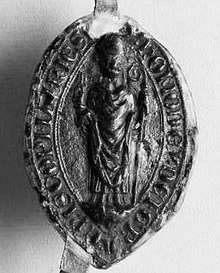Amadeus Pok
Amadeus from the kindred Pok (Hungarian: Pok nembeli Amadé; died 1267 or 1268) was a Hungarian prelate in the 13th century, who served as Bishop of Győr from 1254 until his death.
Amadeus Pok | |
|---|---|
| Bishop of Győr | |
 Seal of Amadeus Pok, 1256 | |
| Appointed | 1254 |
| Term ended | 1267 |
| Predecessor | Artolf |
| Successor | Farkas Bejc |
| Personal details | |
| Died | 1267 or 1268 |
| Nationality | Hungarian |
| Alma mater | University of Bologna |
Background
Amadeus was born into the wealthy and powerful gens (clan) Pok, which possessed large-scale landholdings in Győr County, but his parentage is unknown. He was a contemporary to his distant relative, Maurice II. He was a "frater" (close relative) of Deta and comes John, and he also had two nephews, Paul and Peter, both entered ecclesiastical service and were archdeacons of Sopron.[1]
Amadeus attended the University of Bologna and obtained the terminal degree of doctor of canon law.[2] Returning to Hungary, he served as provost of the collegiate chapter of Vasvár from 1248 to 1254, a royal church, which also functioned as a place of authentication.[3]
Bishop of Győr
After a two-year period of vacancy, Amadeus was elected Bishop of Győr by the cathedral chapter in the spring of 1254.[4] He was a confidant of Béla IV of Hungary, who petitioned to the Roman Curia in order to confirm his election by Pope Innocent IV. In his letter, King Béla IV referred to his conflict and the tense relationship with Ottokar II of Bohemia, which caused the permanent hostile raids at the western boundaries between Hungary and Austria. Due to his family background and wealth, Amadeus was able to protect his chapter, then diocese in the region, similarly to his predecessor, Artolf.[5]
_7.jpg)
The Peace of Pressburg, which was signed on 1 May 1254 and ceded Styria to Hungary, ended the war situation in the region, which lasted more than a decade, thus Amadeus could start his episcopate under calm and relatively peaceful conditions. In the territory of his diocese and the northwestern part of Transdanubia, Amadeus took part in that process, when Béla IV set up special commissions which revised all royal charters of land grants made after 1196. During the implementation of Béla's land reform in the first half of the 1250s, Amadeus frequently acted as co-judge in various lawsuits and border determinations in his diocese, alongside secular barons and his deputy, the archdeacon of Rábaköz. During his activity, Amadeus recovered several landholdings and estates for the Crown. He restored law and administration in the region, which had collapsed after the Mongol invasion and the subsequent Austrian and Bohemian raids. For his advice, Béla IV settled the customs and port duties in Győr and the surrounding area (for instance, Abda and Füzitő), and restored the right to hold markets to Széplak, which was owned by the gens Osl.[5] Amadeus consecrated the parish church of Ják in 1256, today the most complete Romanesque cathedral in Hungary.[1] The internal peace had broken, when the Styrian noblemen rose up in rebellion against the Hungarian rule in 1258, which caused a war between Béla and Ottokar until 1260.[5]
In June 1254, Amadeus filed a lawsuit against the burghers of Sopron over the property right of port duties in Fertőrákos at Lake Fertő (Neusiedl). During the dispute, he even excommunicated the magistrates of the town and placed Sopron under interdict. The litigants were summoned to the judicial court of Béla IV, who judged in favor of the diocese. Thereafter bailiff (royal commissioner) Herbord Osl and a delegate of the Pannonhalma Abbey were sent to draft the custom borders in the region.[6] Amadeus adopted new regulations to the cathedral chapter of Győr and smoothed the contrasts between the canons and the lower clergy. He started to reconstruct his episcopal seat, the Cathedral Basilica of the Assumption of Our Lady, which has been severely damaged during the Mongol invasion. It is plausible the cathedral was redesigned to Romanesque architectural style during his bishopric too. He also permitted the rebuilding of the parish church of Lébény, which was destroyed by Ottokar's troops in the early 1250s.[6] Amadeus attended the national synods in Esztergom (1256) and Buda (1263).[6] Amadeus distanced himself in the conflict between Béla IV and his son Duke Stephen in the 1260s, and did not interfere in secular affairs nor hold dignity in the royal court. He was last mentioned as a living person in August 1267. He died by April 1268, when his successor Farkas Bejc already appeared as bishop-elect.[4]
References
- Karácsonyi 1901, p. 445.
- Győri 2008, p. 26.
- Győri 2008, pp. 28–29.
- Zsoldos 2011, p. 92.
- Győri 2008, p. 31.
- Győri 2008, p. 36.
Sources
- Győri, Éva (2008). "Győri püspökök a XIII. században [The Bishops of Győr in the 13th Century]". Belvedere (in Hungarian). 20 (1–2): 24–43. ISSN 1419-0222.CS1 maint: ref=harv (link)
- Karácsonyi, János (1901). A magyar nemzetségek a XIV. század közepéig. II. kötet [The Hungarian genera until the middle of the 14th century, Vol. 2] (in Hungarian). Hungarian Academy of Sciences.CS1 maint: ref=harv (link)
- Zsoldos, Attila (2011). Magyarország világi archontológiája, 1000–1301 [Secular Archontology of Hungary, 1000–1301] (in Hungarian). História, MTA Történettudományi Intézete. ISBN 978-963-9627-38-3.CS1 maint: ref=harv (link)
Amadeus Born: ? Died: 1267 or 1268 | ||
| Catholic Church titles | ||
|---|---|---|
| Preceded by Artolf |
Bishop of Győr 1254–1267 |
Succeeded by Farkas Bejc |